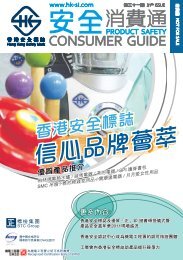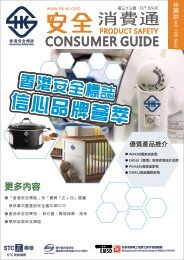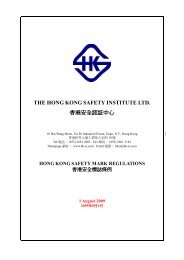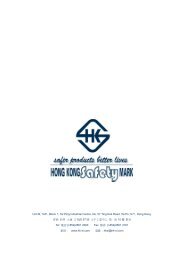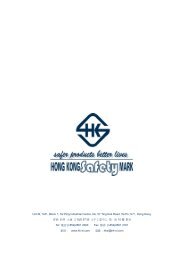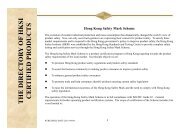Flat 1, 11th Floor, Block 4, Tai Ping Industrial Centre, 51A Ting Kok ...
Flat 1, 11th Floor, Block 4, Tai Ping Industrial Centre, 51A Ting Kok ...
Flat 1, 11th Floor, Block 4, Tai Ping Industrial Centre, 51A Ting Kok ...
You also want an ePaper? Increase the reach of your titles
YUMPU automatically turns print PDFs into web optimized ePapers that Google loves.
<strong>Flat</strong> 1, 11 th <strong>Floor</strong>, <strong>Block</strong> 4, <strong>Tai</strong> <strong>Ping</strong> <strong>Industrial</strong> <strong>Centre</strong>, <strong>51A</strong> <strong>Ting</strong> <strong>Kok</strong> Road, <strong>Tai</strong>po, N.T., Hong Kong<br />
Tel: (852) 2661 2083 Fax: (852) 2661 3181 Homepage: www.hi-si.com E-mail: hksi@hk-si.com
Luminaries Products<br />
Scheme No. : SI/SCH/004<br />
Issue Date : 2011-09-18<br />
Revision : 3
Table of Content<br />
1. INTRODUCTION .......................................................................................................................... 1<br />
2. SCOPE ............................................................................................................................................. 1<br />
3. CERTIFICATION MODE ............................................................................................................. 1<br />
4. CERTIFICATION – PRE-LICENSE STAGE ............................................................................. 2<br />
4.1. APPLICATION TO HONG KONG SAFETY INSTITUTE ..................................................................... 2<br />
4.2. PRODUCT TYPE TEST ................................................................................................................. 2<br />
4.2.1. Classification of Certification Product ............................................................................. 2<br />
4.2.2. Sample preparation ........................................................................................................... 3<br />
4.2.3. Applicable Testing Standards ............................................................................................ 3<br />
4.3. INITIAL FACTORY EVALUATION .................................................................................................. 3<br />
4.3.1. Factory Inspection – Quality Assurance Ability Inspection .............................................. 3<br />
4.3.2. Product Consistency Check .............................................................................................. 4<br />
4.4. OVERALL REVIEW ..................................................................................................................... 4<br />
4.5. ISSUE OF HONG KONG SAFETY MARK LICENSE......................................................................... 5<br />
4.6. CONTINUAL SURVEILLANCE ...................................................................................................... 5<br />
4.6.1. Routine Inspection Visit .................................................................................................... 5<br />
4.6.2. Type Test Assessment ........................................................................................................ 5<br />
5. PRODUCT MODIFICATION ....................................................................................................... 6<br />
6. PRODUCT SCOPE EXTENSION ................................................................................................ 6<br />
7. CERTIFICATION SUSPENSION/ CANCELLATION .............................................................. 7<br />
8. REGULATIONS FOR CERTIFICATION MARK ..................................................................... 8<br />
APPENDIX 1 – PRE-LICENSE OVERVIEW WORK FLOW ....................................................... 11<br />
APPENDIX 2 – TESTING STANDARDS AND REQUIRED SAMPLE ......................................... 12<br />
APPENDIX 3 – CRITICAL COMPONENT REQUIREMENTS .................................................... 13<br />
APPENDIX 4 – FACTORY INSPECTION REQUIREMENTS ...................................................... 14
1. Introduction<br />
The Hong Kong Safety Mark Scheme is an independent certification program for product<br />
safety in Hong Kong.<br />
This document aims to introduce certification requirements of the Hong Kong Safety Mark<br />
(HKSM) Scheme on Luminaries Products.<br />
This Scheme has referenced ISO Guide 67 and Electrical Products (Safety) Regulation (EPSR)<br />
made under the Electrical Ordinance (Cap.406) of HKSAR.<br />
Remark : HKSM Scheme will not address the requirements of Electro-magnetic Compatibility (EMC)<br />
2. Scope<br />
HKSM scheme accepts application from and is accessible to all applicants including<br />
manufacturers, importers, distributors and retailers, so long as the application falls within the<br />
scope of the scheme, which includes, but is not limited to, the following:<br />
• Luminaries, Fixed, General Purpose<br />
Luminaries<br />
• Recessed Luminaries<br />
• Portable General Purpose Luminaries<br />
• Luminaries with built-in transformers for<br />
filament lamps<br />
• Portable Luminaries for Garden Use<br />
• Luminaries for Emergency<br />
• Self-Ballasted Lamps<br />
3. Certification Mode<br />
The scheme adopts a “product-oriented” certification program. Applied products will be sent to<br />
be product type test to relevant testing standards. After complying with test requirements,<br />
HKSI will perform production site assessment. The aim of factory assessment is to ensure<br />
factory has a quality system able to manufacture the certified product steadily and production<br />
Page 1
system complies with requirements.<br />
Hong Kong Safety Mark will be granted to approve product and HKSM license issued to<br />
relevant Subscriber after satisfactory results from type test and factory assessment are<br />
obtained.<br />
Approved products and factories shall also be monitored by continual surveillance program,<br />
which it generally includes routine inspection visit at factory and type test program. The mode<br />
of certification is shown below:<br />
Certification Mode<br />
Product Type Test + Initial Factory Evaluation + Continual Surveillance<br />
4. Certification – Pre-license Stage<br />
4.1. Application to Hong Kong Safety Institute<br />
The Subscriber submits completed HKSM application form (F/001) together with following<br />
information to Hong Kong Safety Institute:<br />
• A copy of Business Registration Certificate ;<br />
• Photos/catalogues/pamphlets of the product(s) ;<br />
• Product specification;<br />
• Bill of Materials;<br />
• Circuit Diagram;<br />
• Assembly or Engineering drawing (if necessary);<br />
• User/Instruction manual.<br />
4.2. Product Type Test<br />
4.2.1. Classification of Certification Product<br />
(a) Individual model: Applicants shall arrange to send applied samples to HKSI. Type test<br />
will be conducted for submitted individual samples.<br />
Page 2
(b) Models in series: If Subscriber has more than one model for application, and such<br />
models have similar structures, functions or components, the representative samples from<br />
all applying models shall be selected for type test. The other models will be selected for<br />
conducting the additional test or verification in respect of the differences.<br />
4.2.2. Sample preparation<br />
Subscribers should submit samples to HKSI. The quantity of samples shall be according to<br />
requirement of Appendix 2. All submitted samples must be completed and good functional, and<br />
all critical components of applied product shall comply with the relevant requirement<br />
mentioned in Appendix 3.<br />
4.2.3. Applicable Testing Standards<br />
The testing standards for certification are specified in Appendix 2.<br />
4.3. Initial Factory Evaluation<br />
4.3.1. Factory Inspection – Quality Assurance Ability Inspection<br />
Factory inspection is to ensure Subscriber of certified product has an ability to produce such<br />
product and to ensure production conditions are complying with the relevant international<br />
requirements, including it has enough facilities, equipment and technique. The regulations of<br />
HKSM scheme shall also be introduced to Manufacturer, which basically include:<br />
• Factory situation complies with information stated in Factory Questionnaire, which is<br />
reported to HKSI upon application being made;<br />
• Hong Kong Safety Mark is granted only to products certified by HKSI;<br />
• The terms of Hong Kong Safety regulations are met when the Hong Kong Safety Mark is<br />
applied for;<br />
• Current Hong Kong Safety Marked production complies with appropriate requirements;<br />
• The required Factory Tests are conducted according to relevant certification report. Test<br />
Records are also maintained;<br />
• The factory test equipment is properly maintained and calibrated;<br />
• The records of customer complaints handling, follow-up action and usage of Safety Mark<br />
are maintained.<br />
The requirements of factory inspection shall be referred to in the Appendix 4<br />
Page 3
4.3.2. Product Consistency Check<br />
If any certified product is available in production line or warehouse, inspector shall select<br />
sample for the related critical component checking against the description of Certification<br />
report. Any difference between inspected sample(s) and description of HKSI certification<br />
report should be recorded in Factory Inspection Report.<br />
Also, the certified product should be checked for the workmanship on safety basis, including<br />
the soldering, welding, torque test for earthing screw, wiring connection, etc.<br />
Inspector shall require Subscriber’s manufacturing facilities to conduct factory tests for the<br />
selected sample. The specification of tests to certified product should refer to Certification<br />
Report’s requirements.<br />
The following marking must be indicated on the HKSM certified product, except the description<br />
on the relevant Certification Report:<br />
(i)<br />
Subscriber identification (Subscriber’s name, trademark and / or HKSI license number,<br />
adjacent to Hong Kong Safety Mark) and Hong Kong Safety Mark logo.<br />
(ii)<br />
Model designation or equivalent.<br />
(iii)<br />
Complete electrical rating of the product (including supply voltage, frequency, and power<br />
consumption.)<br />
(iv) Serial number or date code traceable to month and year of manufacture.<br />
(v)<br />
Instruction manual – all markings or label containing warning or caution words or phrases<br />
given in respect of the safe keeping, use consumption or disposal of the good will have to<br />
appear in both English and Chinese.<br />
(vi) Identification mark – Neutral symbol “N” and Earth symbol must be marked on the<br />
suitable place on the certified product, such as terminal block and connector, etc. (except<br />
type Z attachment)<br />
4.4. Overall Review<br />
Overall assessment review will be performed by HKSI after completion of product type test and<br />
Page 4
factory inspection.<br />
consideration:<br />
During the review, the following reports/records will be taken into<br />
• Information stated in the Application Form<br />
• Type test result<br />
• Result of factory inspection<br />
• Other submitted information/reports/ records for<br />
corrective actions found in certification process.<br />
4.5. Issue of Hong Kong Safety Mark License<br />
Hong Kong Safety Mark License could be granted to Subscribers when satisfactory result of<br />
overall review assessment is obtained. Subscribers are permitted to label HKSM onto certified<br />
products.<br />
The license includes the following information:<br />
• License number<br />
• Date of issue<br />
• Information about Subscriber<br />
• Certificate product information, i.e. product type,<br />
model number<br />
• Applicable standard (s)<br />
• Expiry date of certification<br />
4.6. Continual Surveillance<br />
4.6.1. Routine Inspection Visit<br />
Routine Factory Inspection is conducted on Subscriber’s manufacturing facilities once per<br />
year by HKSI or appointed inspection party. The requirements of factory inspection shall refer<br />
to Appendix 4 and section 4.3.2 Product Consistency Check.<br />
4.6.2. Type Test Assessment<br />
Type Test Assessment is conducted on all categories products as an on-going means to<br />
ascertain that the Hong Kong Safety Marked products are in compliance with the rules and<br />
regulations of the scheme. If a model of the certified products is listed under the license for<br />
every 6 years, samples of the model will be subject to full test to the applicable standards to<br />
which the product is certified. When the testing is complete, HKSI will review the result of the<br />
Page 5
test and follow –up relevant findings as applicable.<br />
5. Product Modification<br />
The Subscriber should inform HKSI of any intended modification on any Certified Product.<br />
Whenever Subscriber requests to modify a Certified Product, Subscriber should submit a<br />
“Modification Request”, which is obtainable from HKSI.<br />
HKSI will evaluate the submitted information from the Subscriber and to make sure that the<br />
following information is clearly stated in the form and / or other records submitted:<br />
• Relevant License Number;<br />
• Proposed type / model of product to be modified;<br />
• Reason(s) for modification;<br />
• Proposed effective date of modification;<br />
• Modification details, which include, but are not<br />
limited to, the following:<br />
Parts list;<br />
Electrical drawings;<br />
Mechanical drawings;<br />
Assembly drawings;<br />
User manual / Instructions<br />
During the course of application review, HKSI will determine whether sample testing on the<br />
modified product is required. If the modification is related to critical item(s) as listed in the<br />
Certification Report of the concerned product, the modified product should undergo the sample<br />
testing process.<br />
6. Product Scope Extension<br />
Subscriber should apply to HKSI for amendment about certification. HKSI will check whether<br />
the submitted application can be processed by reviewing various relevant aspects. If the<br />
application cannot be further processed after the review, the Subscriber will be informed.<br />
If the application can be processed, HKSI will inform the Subscriber in writing. In addition, the<br />
Subscriber will be advised of the detailed certification and surveillance plan for the product and<br />
the fees schedule for different stages.<br />
Page 6
“Endorsement” will be prepared and issued by the HKSI to the Subscriber for the additional<br />
types or models of the products.<br />
Whenever the amendment involves an additional factory to produce the same or different<br />
types or models of products, it comes to the conclusion that a full assessment procedure<br />
should be followed. That is, assessment starting from sample testing, and then submitting<br />
factory questionnaire, and finally, factory inspection.<br />
Another new Hong Kong Safety Mark License will be issued upon complete fulfillment of the<br />
assessment requirements for certification. A new License Number will be assigned<br />
accordingly.<br />
Details of the certification and surveillance plan for the amendment and the fees schedule for<br />
the assessment incurred should be clearly stated in the Certification Proposal after a<br />
conclusion has been made. The Subscriber will be informed of the detailed plan in a<br />
Certification Proposal.<br />
7. Certification Suspension/ Cancellation<br />
The situations in which suspension may be initiated shall include, but not be limited to, the<br />
following:<br />
(a) Voluntary suspension is self-initiated by the Subscriber and is non-disciplinary in nature.<br />
The Subscriber may, by written notice, voluntarily suspend its certification for any or all of<br />
the products for which it holds certification.<br />
(b) Delay of payment : When any payment becomes overdue by 2 months, HKSI may send a<br />
letter to the Subscriber warning of the possibility of suspension of certification.<br />
(c) Delay of Routine Inspection Visit (RIV) : When the scheduled RIV has been overdue by 3<br />
months, the HKSI will send a letter to the Subscriber warning of the possibility of<br />
suspension of certification.<br />
(d) Other Matters<br />
• The surveillance shows non-compliance with the Requirements of a serious nature but<br />
immediate withdrawal is not necessary;<br />
• Serious customer complaints;<br />
Page 7
• Breach of the Hong Kong Safety Mark Regulations or any other contravention of the rules<br />
of the Scheme or the procedures of HKSI;<br />
• Misuse of the Mark or the License, e.g. misleading prints or advertisement not solved by<br />
suitable retraction or appropriate remedial measures by the Subscriber;<br />
• Reported incidence from the public.<br />
The Suspension can only last for a maximum of 2 years, or the period specified in the<br />
Suspended Notification Letter.<br />
The Subscriber can initiate resumption of certification by a written request to HKSI within the<br />
allowable suspension period specified in the Suspension Notification Letter. After the receipt of<br />
the Subscriber’s request, HKSI will evaluate whether the Subscriber has fulfilled the<br />
resumption conditions as indicated in the Suspension Notification Letter.<br />
The circumstances in which cancellation of certification will be initiated include, but are not<br />
limited to, the following:<br />
(a) If the surveillance visit shows that the non-compliance is of a serious nature;<br />
(b) If there is any serious contravention to the Hong Kong Safety Mark Regulations;<br />
(c) If inadequate corrective measures are taken by the Subscriber in the case of suspension;<br />
If a Subscriber desires to cancel the Certification, the Subscriber should notify HKSI in writing<br />
stating the proposed date for terminating the Hong Kong Safety Mark Regulations.<br />
Resumption of Certification will go through the normal application and assessment procedures.<br />
A new License number will be issued on successful completion of certification.<br />
8. Regulations for Certification Mark<br />
The use of Hong Kong Safety Mark License and Hong Kong Safety Mark is subject to certain<br />
conditions as outlined below:<br />
The Hong Kong Safety Mark and the License are the properties of the Hong Kong Safety<br />
Institute. HKSI has full control over the use and display of License and the Mark.<br />
Subscriber authorized to use the Mark and License shall ensure that they are used in<br />
accordance with the regulations and requirements laid down in this document, the Hong Kong<br />
Safety Mark Regulations and the “Your Guide to Certification”.<br />
Page 8
When certification of the product has been authorized there shall be a marking to indicate<br />
compliance with the Hong Kong Safety Institute’s requirements in the form outlined below.<br />
Under no circumstances should a product bearing the Hong Kong Safety Mark be released to<br />
the market prior to authorize certification.<br />
The Hong Kong Safety Mark may appear in any size provided it is not less than 5mm in height.<br />
The Mark can be enlarged or reduced with its aspect ratio remaining unchanged. Where<br />
limitations of space prevent the use of the Mark in the minimum size (i.e. 5mm in height),<br />
requests to use a Mark of smaller dimensions will be considered by HKSI on the basis of<br />
legibility.<br />
The Hong Kong Safety Mark on any Certified Product will be identified with the holder of the<br />
License.<br />
The Hong Kong Safety Mark shall be marked together with HKSI License Number*. It should<br />
be placed adjacent to the model’s identity as far as possible.<br />
Mark<br />
L12345 A<br />
HKSI License Number<br />
* The HKSI License Number shall be adjacent to the Hong Kong Safety Mark.<br />
This number is recorded in the “Directory of HKSI Certified Products”.<br />
Page 9
Where the Hong Kong Safety Mark is permitted to appear on a product by a separate marking<br />
medium, HKSI License Number shall be included in the design of the separate marking<br />
medium.<br />
The Hong Kong Safety Mark should be applied in such a way that is easily visible, clear, legible,<br />
and reliable and prevents it from deterioration. The Hong Kong Safety Mark may only be<br />
applied at factory locations or other sites, as specified and approved by HKSI.<br />
- End of Certification Scheme -<br />
Page 10
Appendix 1 – Pre-License Overview Work Flow<br />
Page 11
Appendix 2 – Testing Standards and Required Sample<br />
Product<br />
Testing Standard<br />
Required<br />
Samples<br />
Luminaries, Fixed, General<br />
Purpose Luminaries<br />
IEC60598-2-1:1979+A1:1987 3<br />
Recessed Luminaries IEC60598-2-2: 1996+A1:1997 3<br />
Portable General Purpose<br />
Luminaries<br />
Luminaries with built-in<br />
transformers for filament lamps<br />
Portable Luminaries for Garden<br />
Use<br />
IEC60598-2-4:1997 3<br />
IEC60598-2-6:1994+A1:1996 3<br />
IEC60598-2-7:1982+A1:1987+A2:1994 3<br />
Luminaries for Emergency IEC60598-2-22:1997+A1:2002+A2:2008 3<br />
Self-Ballasted Lamps for general<br />
lighting services<br />
IEC60968:1988+A1:1991+A2:1999 6<br />
Page 12
Appendix 3 – Critical Component Requirements<br />
Item No. Component Name<br />
Reference Standard<br />
1. Power Cord BS6500, IEC60227, IEC60245, IEC60799,<br />
IEC60702 or equivalent<br />
2. Plug BS1363, BS546, or equivalent<br />
3. Receptacle IEC60320-1 or equivalent<br />
4. Inlet IEC60320-1 or equivalent<br />
5. Switch IEC61058-1, IEC60669 (fixed) or equivalent<br />
6. Current Fuse IEC60127, or equivalent<br />
7. Thermostat IEC60730-2-9 or equivalent<br />
8. Thermal fuse IEC60691 or equivalent<br />
9. Relay EN60255-23 or EN61810-1 or equivalent<br />
10. Timer IEC60730-2-7 or equivalent<br />
11. Lampholder IEC60238, IEC60400, IEC60061, IEC60838,<br />
IEC61184 or equivalent<br />
12. Ballast IEC61347 or equivalent<br />
13. Startor IEC60155<br />
14. Inductor / Choke IEC61347<br />
15. Capacitor IEC60384, IEC60252, EN132400<br />
16. Fuse Holder IEC60127-6 or equivalent<br />
17. Print circuit board IEC60598 or equivalent<br />
18. Plastic Enclosure IEC60598 or equivalent<br />
19. Terminal <strong>Block</strong> IEC60998, IEC60999 (screwless)<br />
20. Transformer IEC61558 or equivalent<br />
21. Internal Lead wire UL grade certificate<br />
Page 13
Appendix 4 – Factory Inspection Requirements<br />
This guideline provides the basic acceptable standard. Where considered necessary by HKSI,<br />
additional requirements/ tests shall be specified.<br />
1. Purchased Material<br />
Manufacturers must ensure that all purchased materials and services conform to specified<br />
requirements.<br />
2. Incoming Goods Inspection System<br />
The manufacturer must have adequate facilities for checking, receiving and storing incoming<br />
goods. Incoming goods that have a safety implication on the finished product shall be verified<br />
as complying with the appropriate specification.<br />
If manufacturer relies on Certificates of Conformity to underwrite the quality of incoming goods,<br />
such Certificates must clearly identify the products to which they refer, the quantity of items<br />
covered the relevant specification with which the goods comply.<br />
3. In-process quality control<br />
Inspector shall determine whether checking methods in production used by the manufacturer<br />
effectively control the quality of product and ensure conformity with that of the sample that was<br />
originally approved. Production must be inspected at appropriate stages of manufacture to<br />
ensure that all piece-parts, components, sub-assemblies and wiring runs are in accordance<br />
with the sample against which products are certified.<br />
The manufacturer shall fully document, and maintain up to date, the complete schedule of<br />
tests and inspections to be carried out on each product. The records of all inspections and<br />
quality checks shall be monitored and the results, including any trends, shall be regularly<br />
reported to production control.<br />
4. Factory Routine Test<br />
Inspector shall witness relevant factory tests to be carried out on production items, by the<br />
manufacturer, in order to establish that the certified products continue to meet the level of<br />
conformity.<br />
Page 14
These tests are intended to reveal a variation during manufacture, which could impair safety<br />
and are to be carried out on each appliance. Safety tests should cover both electrical and<br />
physical/mechanical safety aspects. Manufacturer may perform the tests at an appropriate<br />
stage during production, and normally carried out on the complete products. All records related<br />
to factory tests shall be maintained, including the type and results of the tests, non-conforming<br />
products handling.<br />
5. Test Equipment<br />
The equipment used for electrical and mechanical safety testing on the production line or by<br />
the quality control or quality audit departments, must be routinely checked and calibrated for<br />
correct operation.<br />
(a) An operational or functional check must be undertaken on a daily basis or at a frequency<br />
that will allow previous production to be re-tested, if incorrect functioning of the test<br />
equipment is detected. Typically, this check can be satisfied by applying the test<br />
equipment to a predetermined fault condition that constitutes a marginal failure. Operators<br />
must be instructed on what action to take if a check test proves unsatisfactory and must<br />
record these daily checks, together with any corrective action taken.<br />
(b) Measuring instruments and test equipment used for determining the safety of the products<br />
being manufactured shall be calibrated on a regular basis. All calibrations undertaken on<br />
such equipment must be traceable to national or other recognized standards. Records of<br />
calibrations undertaken for each instrument must be kept.<br />
6. Records<br />
The manufacturer must maintain appropriate records, for a minimum period of between two<br />
inspection visits, to substantiate conformance with specified requirements in a legible and<br />
identifiable. Such records should include the following:<br />
• Inspection records of safety critical components;<br />
• In-process quality control;<br />
• Certificates of Conformity;<br />
• Testing standards for certified product;<br />
• Operator training;<br />
• Routine tests, including results of functioning<br />
checks on test equipment;<br />
• Calibration information.<br />
Page 15
7. Handling and storage<br />
Inspector shall check the condition of storage of components, semi-assemblies and finished<br />
products. All of these must be handled and stored to avoid damage and in such a way as to<br />
ensure continued compliance with applicable standards.<br />
8. Customer complaints<br />
Manufacturer should record all customer complaints related to HKSM certified product. The<br />
description and cause of complaint, the corrective action taken by subscriber and the result of<br />
handling should be recorded. Inspector also should record any serious nature in the Factory<br />
Inspection Report.<br />
9. Consumption of Hong Kong Safety Mark Label<br />
Subscriber should be advised to keep a production record during Initial Factory Evaluation<br />
(IFE) inspection. Inspector should check the production record and quantity in every visit and<br />
record details on inspection report. It should include the following:<br />
(i)<br />
How many quantities have been produced since the last visit?<br />
(ii) How many quantities have been produced since the last visit to December 31?<br />
Page 16





